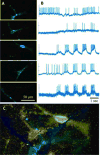All-Optical Electrophysiology for Disease Modeling and Pharmacological Characterization of Neurons
- PMID: 28892145
- PMCID: PMC5721518
- DOI: 10.1002/cpph.25
All-Optical Electrophysiology for Disease Modeling and Pharmacological Characterization of Neurons
Abstract
A key challenge for establishing a phenotypic screen for neuronal excitability is measurement of membrane potential changes with high throughput and accuracy. Most approaches for probing excitability rely on low-throughput, invasive methods or lack cell-specific information. These limitations stimulated the development of novel strategies for characterizing the electrical properties of cultured neurons. Among these was the development of optogenetic technologies (Optopatch) that allow for stimulation and recording of membrane voltage signals from cultured neurons with single-cell sensitivity and millisecond temporal resolution. Neuronal activity is elicited using blue light activation of the channelrhodopsin variant 'CheRiff'. Action potentials and synaptic signals are measured with 'QuasAr', a rapid and sensitive voltage-indicating protein with near-infrared fluorescence that scales proportionately with transmembrane potential. This integrated technology of optical stimulation and recording of electrical signals enables investigation of neuronal electrical function with unprecedented scale and precision. © 2017 by John Wiley & Sons, Inc.
Keywords: CheRiff; Optical electrophysiology; Optopatch; QuasAr; disease modeling; induced pluripotent stem cell; optogenetics; voltage indicator.
Copyright © 2017 John Wiley & Sons, Inc.
Conflict of interest statement
Figures





References
-
- Ans B, Hérault J, Jutten C. Architectures neuromim{é}tiques adaptatives: D{é}tection de primitives. Proceedings of “Cognitiva. 1985;85:593–597.
-
- Bales KL, Solomon M, Jacob S, Crawley JN, Silverman JL, Larke RH, Sahagun E, Puhger KR, Pride MC, Mendoza SP. Long-term exposure to intranasal oxytocin in a mouse autism model. Translational psychiatry. 2014;4:e480. Available at: http://www.pubmedcentral.nih.gov/articlerender.fcgi?artid=4259989&tool=p.... - PMC - PubMed
-
- Di Giorgio FP, Boulting GL, Bobrowicz S, Eggan KC. Human embryonic stem cell-derived motor neurons are sensitive to the toxic effect of glial cells carrying an ALS-causing mutation. Cell stem cell. 2008;3:637–48. Available at: http://www.ncbi.nlm.nih.gov/pubmed/19041780 [Accessed August 25, 2014] - PubMed
-
- DeMattos RB, Bales KR, Cummins DJ, Dodart JC, Paul SM, Holtzman DM. Peripheral anti-A beta antibody alters CNS and plasma A beta clearance and decreases brain A beta burden in a mouse model of Alzheimer’s disease. Proceedings of the National Academy of Sciences of the United States of America. 2001;98:8850–5. Available at: /pmc/articles/PMC37524/?report=abstract. - PMC - PubMed
MeSH terms
Grants and funding
LinkOut - more resources
Full Text Sources
Other Literature Sources

